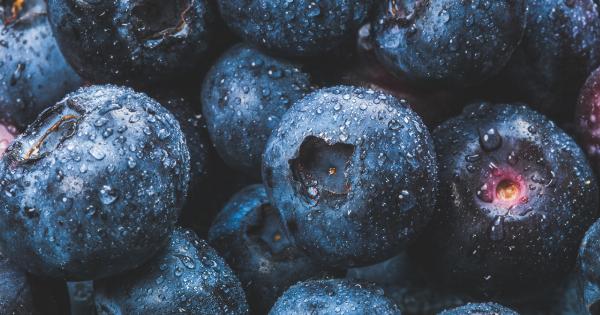Migraines are severe headaches that can cause intense pain, sensitivity to light and sound, nausea, and vomiting.
While the exact cause of migraines is still not fully understood, studies have shown that certain foods and drinks can trigger migraines in some individuals. These triggers can vary from person to person, but being aware of common migraine triggers can help you manage your condition better.
In this article, we will explore the relationship between food and migraines and provide tips on how to eat for prevention.
Common Food Triggers for Migraines
It is important to note that not all migraine sufferers will have the same triggers, and some individuals may not have any food triggers at all.
However, there are several common food and drink substances that have been known to trigger migraines in susceptible individuals. These include:.
1. Caffeine
While caffeine can provide temporary relief for headaches, it can also be a trigger for migraines. Abruptly stopping or reducing caffeine intake can also cause migraines as the body goes through withdrawal.
It is important to find the right balance for your caffeine consumption if you are prone to migraines.
2. Alcohol
For some individuals, alcohol, especially red wine, can trigger migraines. This may be due to the presence of certain compounds, such as histamines and tannins, which can dilate blood vessels and trigger migraines in susceptible individuals.
It is advisable to limit alcohol consumption or avoid it altogether if you notice a connection between alcohol and your migraines.
3. Aged Cheeses
Certain cheeses, such as blue cheese, cheddar, Swiss, and mozzarella, contain a substance called tyramine, which has been known to trigger migraines in some individuals.
Tyramine forms when proteins in foods break down over time, so aged or fermented foods are more likely to have higher levels of this trigger. If you suspect cheese to be a trigger for your migraines, try opting for fresher, low-tyramine alternatives.
4. Artificial Sweeteners
Sugar substitutes like aspartame and saccharin have been reported to trigger migraines in some people.
While more research is needed to fully understand the connection, it may be worth avoiding or limiting the consumption of food and drinks that contain artificial sweeteners if you experience migraines.
5. Monosodium Glutamate (MSG)
MSG is a flavor enhancer commonly found in processed and packaged foods, as well as some restaurant dishes. It is often used to enhance the savory taste in these foods. Some individuals are sensitive to MSG and may experience migraines as a result.
Pay attention to food labels and try to avoid or limit foods that contain MSG if you suspect it to be a trigger.
6. Chocolate
Chocolate is a common trigger for migraines due to the presence of theobromine and caffeine. Dark chocolate tends to have higher levels of these compounds, making it more likely to trigger migraines in susceptible individuals.
If chocolate consistently triggers your migraines, it may be best to avoid or limit your consumption.
7. Citrus Fruits
While citrus fruits are generally considered healthy, they can trigger migraines in some individuals. This may be due to the high levels of tyramine present in certain citrus fruits, such as oranges and lemons.
If you notice a correlation between citrus fruits and your migraines, you may want to reduce your intake or opt for low-tyramine fruits like bananas or grapes.
8. Nitrates and Nitrites
Nitrates and nitrites are additives commonly found in processed meats, such as bacon, hot dogs, and deli meats. These additives can trigger migraines in some individuals.
Be mindful of the ingredients in processed meats and try to choose nitrate- and nitrite-free options whenever possible.
9. Onions and Garlic
Onions and garlic contain substances that can trigger migraines in susceptible individuals. These substances, known as sulfites, can cause blood vessels to dilate and lead to headaches.
If onions and garlic consistently trigger your migraines, consider reducing your intake or exploring alternatives to flavor your food.
10. Food Additives and Preservatives
Various food additives and preservatives, such as sodium benzoate, can trigger migraines in some individuals. These additives are often found in processed and packaged foods.
Reading labels and opting for whole, fresh foods can help minimize exposure to these potential triggers.
Eating for Migraine Prevention
While it can be challenging to pinpoint exactly which foods are triggering your migraines, keeping a food diary can help you identify potential connections between certain foods and your migraines.
If you suspect that certain foods are triggering your migraines, try eliminating them from your diet for a few weeks and see if there is any improvement in the frequency or severity of your migraines.
Additionally, following a healthy and balanced diet can contribute to overall migraine prevention. Here are some tips on how to eat for prevention:.
1. Stay Hydrated
Dehydration can be a trigger for migraines, so it is vital to stay hydrated throughout the day. Aim to drink at least eight glasses of water daily and limit your intake of dehydrating beverages like caffeinated drinks and alcohol.
2. Maintain Stable Blood Sugar Levels
Rapid drops or spikes in blood sugar levels can potentially trigger migraines. To keep your blood sugar stable, opt for complex carbohydrates like whole grains, legumes, and fruits and vegetables.
These foods are rich in fiber and will provide a steady release of energy.
3. Eat Regularly
Skipping meals or going too long without eating can disrupt blood sugar levels and increase the risk of migraines. Try to establish regular eating patterns and aim for three balanced meals and healthy snacks in between, if needed.
4. Include Magnesium-Rich Foods
Magnesium has been found to have a potential preventive effect on migraines. Incorporate magnesium-rich foods into your diet, such as leafy green vegetables, nuts and seeds, whole grains, and legumes.
5. Limit Trigger Foods
If you have identified specific trigger foods through your food diary, try to eliminate or limit them from your diet. Pay attention to any changes in your migraine patterns after removing these triggers.
6. Practice Mindful Eating
Eating in a calm and relaxed environment can aid digestion and potentially prevent migraines. Avoid eating on the go or while stressed, as this can lead to indigestion and trigger migraines in some individuals.
7. Consider Supplements
If you struggle to obtain enough nutrients from your diet alone, certain supplements may be beneficial for migraine prevention. Magnesium and riboflavin (vitamin B2) supplements have been studied for their potential migraine prevention properties.
However, consult with a healthcare professional before starting any new supplements.
8. Reduce Stress
Stress can contribute to migraines in many individuals. Practice stress-management techniques, such as deep breathing exercises, meditation, yoga, or engaging in hobbies, to reduce the overall stress in your life.
9. Get Regular Exercise
Regular physical activity can help reduce the frequency and severity of migraines. Aim for at least 30 minutes of moderate-intensity exercise, such as brisk walking or cycling, on most days of the week.
However, be aware that intense exercise can also trigger migraines in some individuals, so find a balance that works for you.
10. Get Sufficient Sleep
Lack of sleep can increase the risk of migraines. Establish a regular sleep schedule and aim for seven to eight hours of quality sleep each night. Create a dark, quiet, and comfortable sleeping environment to promote better sleep.
By being mindful of your diet, staying hydrated, and managing stress levels, you can take steps towards preventing migraines and improving your overall well-being.





























